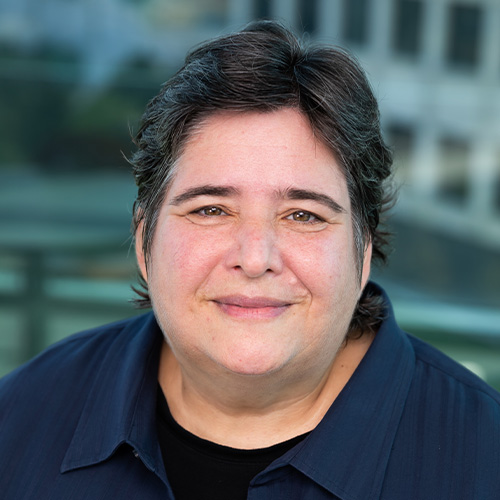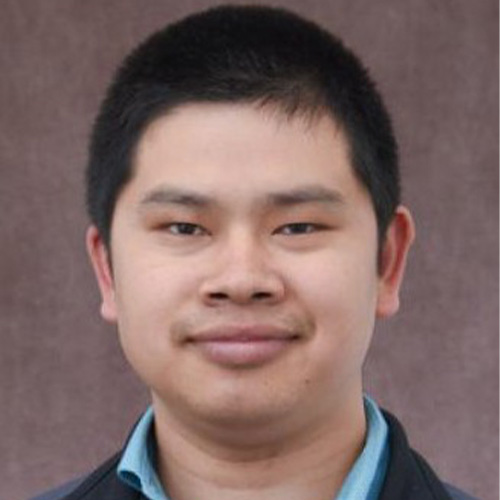This image shows the atomic structure of radial spoke 3 (multicolor), a key regulator in motile cilia. In the background is a cryo-electron microscopy image of a peripheral microtubule with regularly spaced radial spokes projecting upward; overlaid in color is its atomic model, showing the arrangement of protein components.
DALLAS – July 22, 2025 – A team led by UT Southwestern Medical Center researchers has uncovered the atomic structure of a protein complex pivotal to the function of motile cilia, the hair-like structures extending from the surfaces of many cell types that generate their movement.
The researchers’ findings involving radial spoke 3 (RS3), reported in Nature Structural & Molecular Biology, help answer some fundamental questions about how motile cilia work and could eventually lead to new treatments for ciliopathies, diseases in which cilia’s structure and/or function are impaired. These include primary ciliary dyskinesia, a life-shortening genetic disorder that causes infertility, chronic respiratory problems, reversed organ placement, and excess brain fluid.

Daniela Nicastro, Ph.D., is Professor of Cell Biology at UT Southwestern. She played a pivotal role in establishing UTSW’s Cryo-Electron Microscopy Facility.
“Our findings reveal RS3 as a unique hub connecting mechanical support with energy production and recycling in these highly conserved, motion-generating organelles,” said Daniela Nicastro, Ph.D., Professor of Cell Biology at UT Southwestern. Dr. Nicastro co-led the study with Xuewu Zhang, Ph.D., Professor of Pharmacology and Biophysics, and first author Yanhe Zhao, Ph.D., Research Scientist in the Nicastro Lab.

Xuewu Zhang, Ph.D., is Professor of Pharmacology and Biophysics at UT Southwestern. He is a Virginia Murchison Linthicum Scholar in Medical Research.
Cilia are ubiquitous on cells, playing a variety of roles, Dr. Nicastro explained. While non-motile cilia serve as sensors for chemical and mechanical signals, motile cilia rhythmically beat to propel some types of cells through fluid or to move small objects and fluid in their environment and across tissues.
Scientists have long known that the oscillatory beating of a motile cilium is generated by thousands of molecular motor proteins called dyneins. But how cells coordinate their actions to whip cilia back and forth and where the energy driving this motion comes from has been unclear.
To help answer these questions, researchers at UTSW and elsewhere have investigated the structures of various protein complexes that make up motile cilia’s inner workings. Most of these studies have used model organisms, such as the single-celled green algae Chlamydomonas, that move through their aquatic habitats with two motile cilia.

Yanhe Zhao, Ph.D., is a Research Scientist in the Nicastro Lab.
Three of these ciliary complexes compose structures called radial spokes, which repeat many times along the length of cilia and connect the peripheral microtubule-cylinder that holds the dynein motors to a central spine, so that in cross-section the radial spokes look like the spokes of a wheel. While the structures of Chlamydomonas’ radial spoke complexes 1 and 2 (RS1 and RS2) mirror those found in mammals, including humans, the algal RS3 is much shorter than the mammalian complex. Studies by the Nicastro Lab have shown patients carrying mutations that affect RS1 and RS2 but leave RS3 intact have less severe ciliopathies than those where RS3 is also affected, suggesting RS3 is uniquely important for cilia function. However, RS3’s molecular structure had been unknown.
To solve the mammalian RS3 structure, Drs. Nicastro, Zhang, and Zhao and their colleagues used a variety of approaches to study mouse RS3, including high-tech imaging from cryo-electron microscopy (cryo-EM) and cryo-electron tomography as well as proteomics and computational biology. Their investigation revealed that mammalian RS3 is made of 14 proteins, 10 of which were previously unknown to be part of this complex. By matching these proteins to those in a comprehensive mouse protein database, the researchers identified them and their functions.
Dr. Zhao said several of RS3’s proteins are involved in placing or removing phosphate groups from other proteins – a regulatory function that he and his colleagues suspect plays a part in coordinating the activity of the dynein motors. Several other proteins in this complex are involved in generating ATP, a fuel that cells use for energy and that drives dynein motion. Together, he said, these findings suggest RS3’s components are pivotal for both synchronizing dynein activity and powering the motors’ motion in cilia.
RS3’s structure could act as a blueprint for designing drugs that modify its activity, Dr. Zhang said. Such therapies could eventually be used to treat ciliopathies such as polycystic kidney disease and primary cilia dyskinesia. The researchers plan to continue investigating the individual roles and interactions of proteins that make up RS3 and how this structure might differ among species.
Dr. Nicastro played a pivotal role in establishing UTSW’s Cryo-EM Facility, which she directed until December 2019. Dr. Zhang is a Virginia Murchison Linthicum Scholar in Medical Research.
This study was funded by grants from the National Institutes of Health (R01GM083122 and R35GM130289) and the Cancer Prevention and Research Institute of Texas (RR140082).
About UT Southwestern Medical Center
UT Southwestern, one of the nation’s premier academic medical centers, integrates pioneering biomedical research with exceptional clinical care and education. The institution’s faculty members have received six Nobel Prizes and include 25 members of the National Academy of Sciences, 24 members of the National Academy of Medicine, and 14 Howard Hughes Medical Institute Investigators. The full-time faculty of more than 3,200 is responsible for groundbreaking medical advances and is committed to translating science-driven research quickly to new clinical treatments. UT Southwestern physicians provide care in more than 80 specialties to more than 140,000 hospitalized patients, more than 360,000 emergency room cases, and oversee nearly 5.1 million outpatient visits a year.
